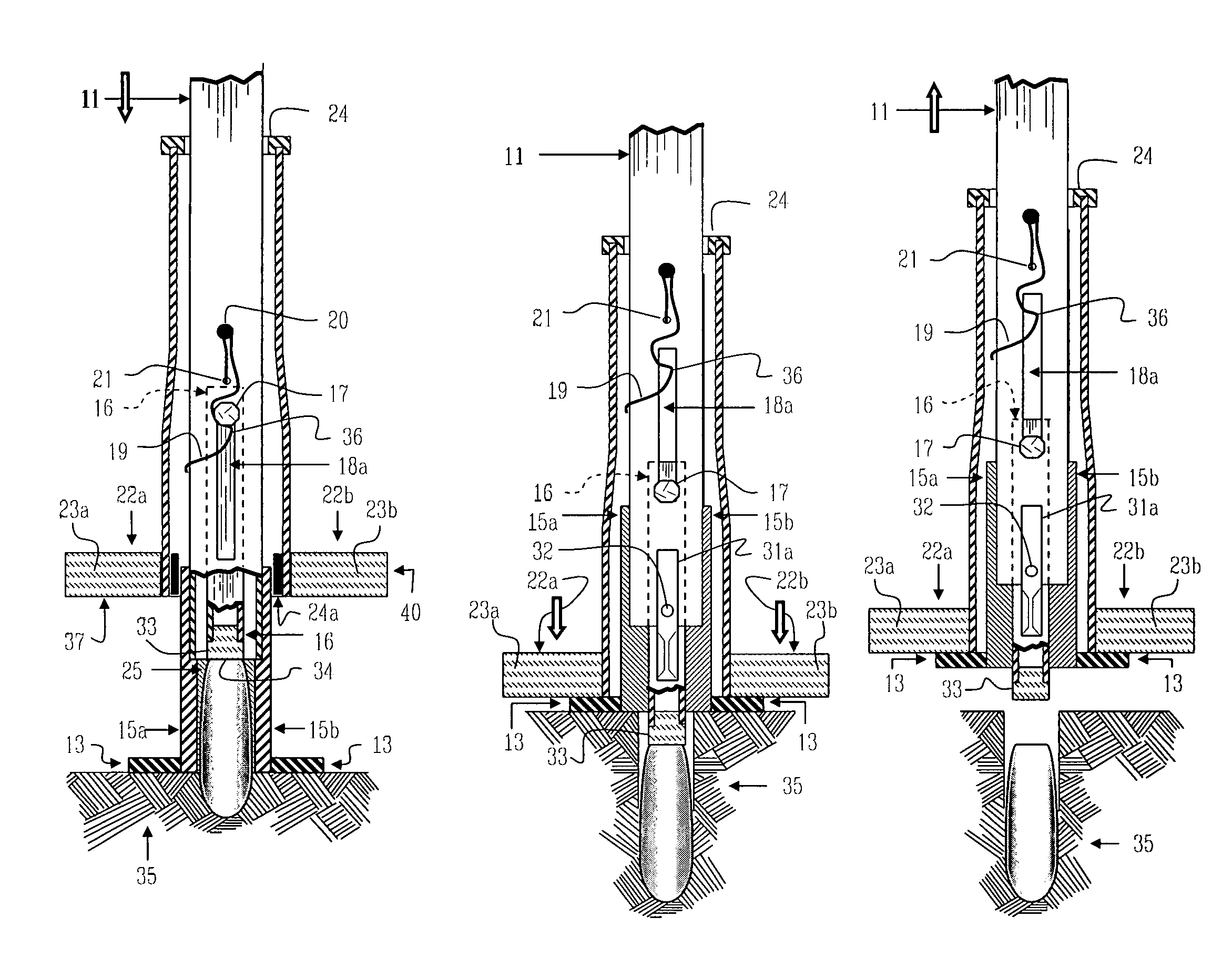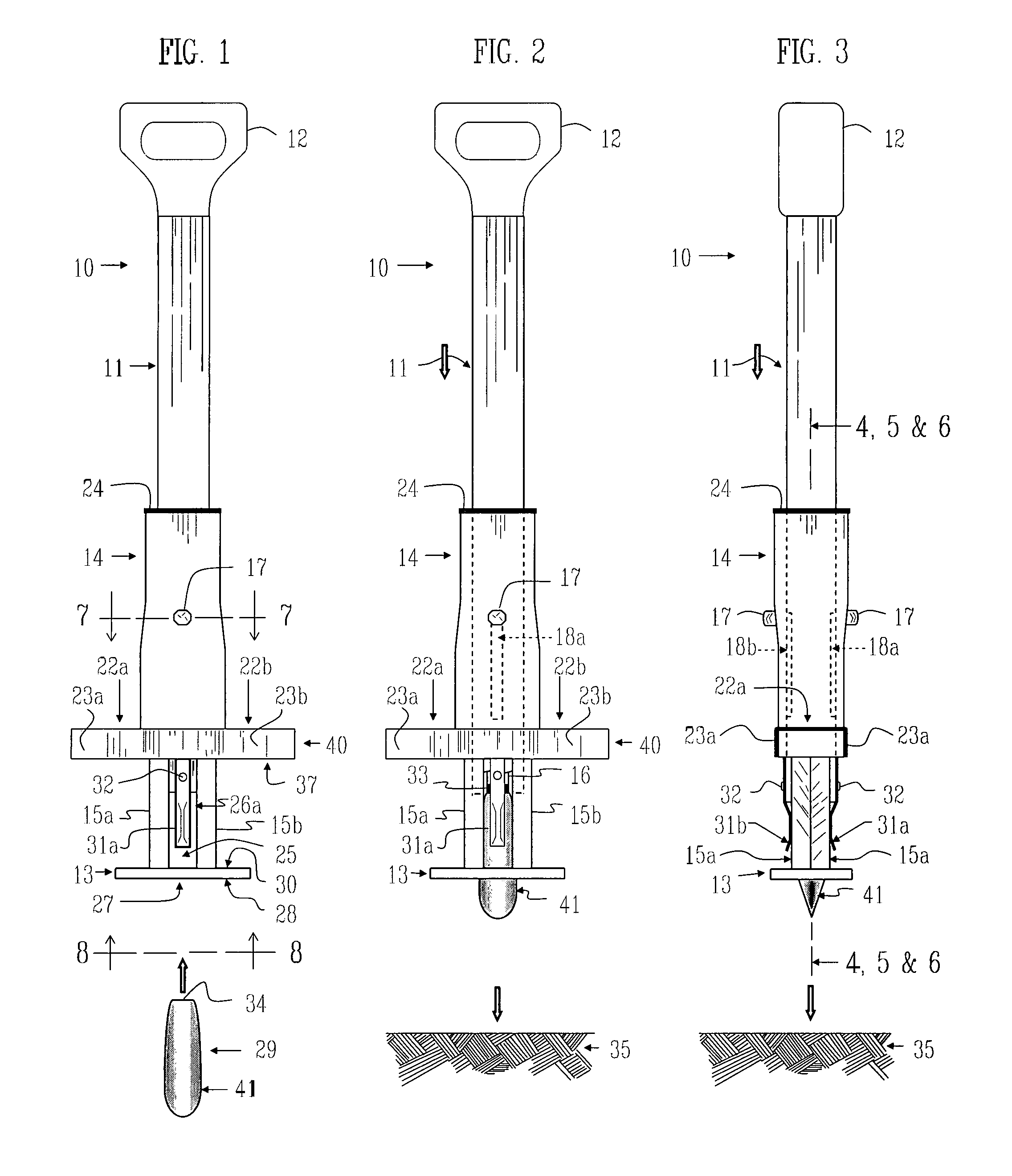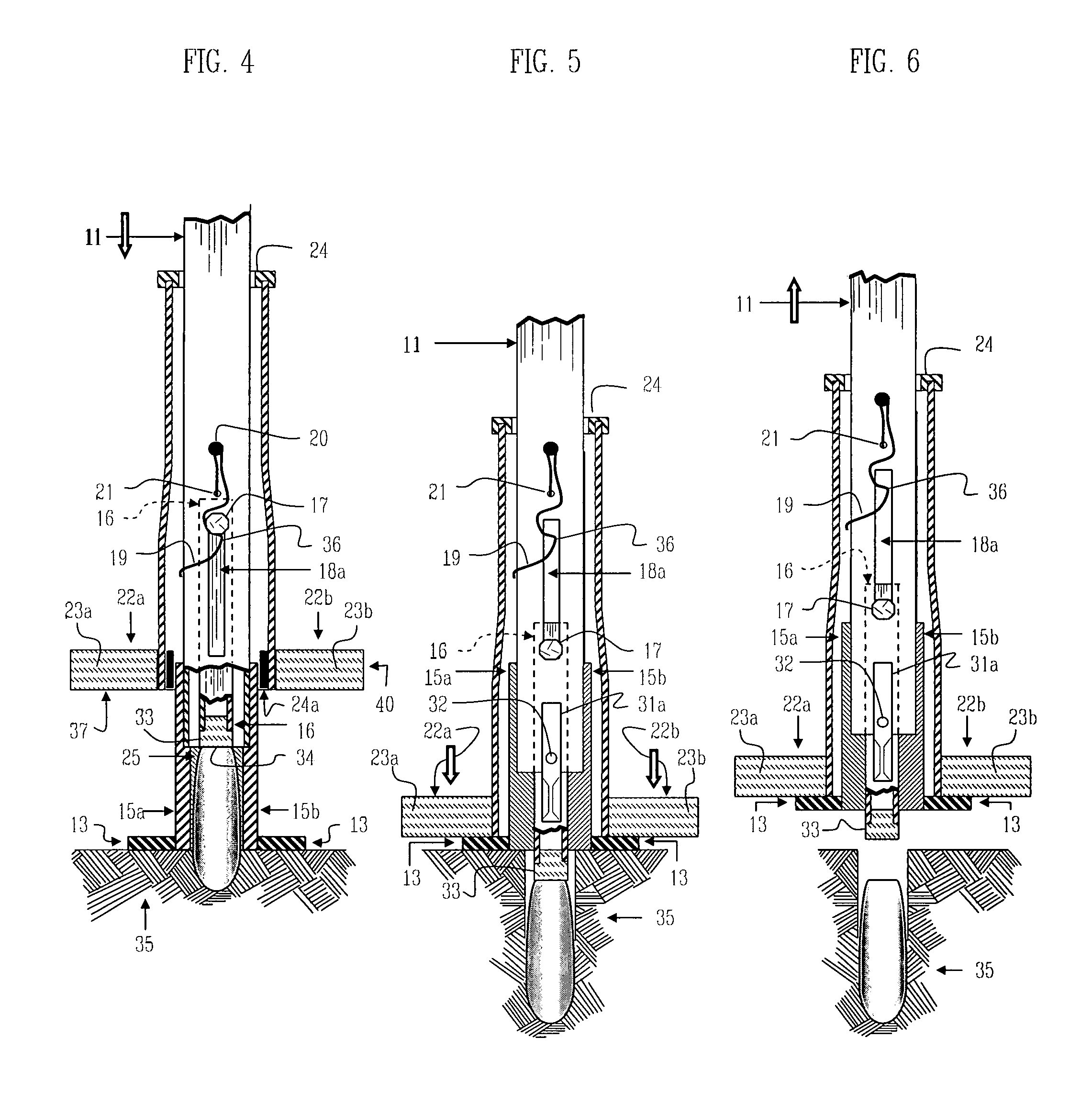Further, this prior art requires the striker rod to be extended through from the base to the entire length to the
handle resulting in added cost.
Also, this striker rod is weighted adding extraneous operator energy and material cost.
This single-foot and off-balance pedal operation tends to cause binding of the sliding foot pedal mechanism to the wall of the structure that contains it as well performing this operation concurrent with the ramming of the tool with one hand and stabilizing the tool with the other hand, results in unstable and off-balance operation, a limited operator force derived and extraneous operator energy.
Further, the addition of this alternate embodiment of the invention adds extraneous material costs, operator time and effort in the injection and ejection processes.
Further still, problems arise when a component of the tool is injected into the soil concurrent with the fertilizer spike.
This requires extraneous operator energy and effort in the injection and ejection process and from soil being forced between the fertilizer spike and the walls of the fertilizer spike retention fingers and the securement spikes as well as requiring maintenance prior to it's next use from
dirt attaching to the securement spikes and
dirt clogged between the securement spikes and the plurality of fertilizer spike retention fingers.
Should the device by Bishop be considered for the purpose of injecting fertilizer spikes, it would suffer the aforementioned problems consistent with prior art designed on hand / arm /
shoulder movement to activate a rod within the tool to inject the fertilizer spike into the soil by repeatedly ramming it.
The fertilizer spike
injector tool disclosed by Fiedler has numerous and obvious structural and operational differences compared to the new invention and as such suffer from a number of problems.
One problem arises when a component of the tool is injected into the soil as part of the fertilizer spike injection process.
Operational problems include: extraneous operator time, energy and effort required in the injection and ejection processes from overcoming the added friction from injecting extraneous
mass, from the soil adhering to the perimeter of the extraneous
mass and from clogging and jamming of the fertilizer spike load chamber and / or the fertilizer spike retention mechanism with soil forced between the fertilizer spike and the walls of the fertilizer spike chamber and / or the fertilizer retention mechanism thereby failing to inject or eject the fertilizer spike, requiring maintenance prior to it's next use and causing a decreased range of soil firmness condition applications; difficult, complex, awkward or supplemental procedures and / or special expertise to inject the fertilizer spike into the soil; difficult, complex, awkward or supplemental procedures and / or special expertise to remove the tool from the soil after injecting the fertilizer spike while leaving the fertilizer spike behind by awkwardly activating attachments to the device with one hand, while concurrently, having to pull upward on the tool with the other hand; maintenance of the tool after removing the tool from the soil from soil adherence;
exposure to
corrosion form
soil contamination and the inability to have simultaneous injection of the fertilizer spike into the soil with the ejection of the fertilizer spike from the fertilizer spike load chamber and the fertilizer spike retention mechanism.
A further problem with this prior art is in the engagement of the fertilizer spike by angularly outwardly extending fingers at the end of the driver rod.
A further problem with this prior art is that, while there is the engagement of the fertilizer spike by angularly outwardly extending fingers at the end of the driver rod to contain the fertilizer spike within the slideable driver rod, there is no containment / engagement mechanism of the slideable driver rod itself.
Consequently, once the spike has been loaded into the engaging end of the slideable driver rod and the tool is inverted for placement on the ground, the weight of the slideable driver rod, which extends the full length of the tool, causes uncontrolled sliding of the driver rod resulting inadvertently releasing the fertilizer spike by being jarred out of it's engagement with the driver rod as well as exposing the operator to pinching from the exposed travel slot actuating mechanism of the fertilizer ejection knob.
A further problem with this prior art is the excessive step-up height to the foot ledge resulting in unstable and off-balance operation as well as use of extraneous operator energy and effort.
Should the device by Allison and Willis be considered for the purpose of injecting fertilizer spikes, it would suffer the problems consistent with prior art described previously herein where: a component of the tool is injected into the soil as part of the injection process and as such, problems relate to both the ejection and ejection processes; the tool relies on a single-foot and off-centre pedal for injection of the fertilizer spike; the excessive step-up height to the foot ledge resulting in unstable and off-balance operation as well as use of extraneous operator energy and effort; there is no driver Rod or contact surface at the end of the tool to engage the driving end of the fertilizer stake and there is no ejector rod or contact surface at the end of the tool to engage the driving end of the fertilizer stake or other means to eject the fertilizer spike after
insertion.
The fertilizer spike
injector tool disclosed by Winkler has numerous and obvious structural and operational differences compared to the new invention and as such suffer from a number of aforementioned problems consistent with other prior art.
One problem arises where the tool relies on a single-foot and off-centre pedal for injection of the fertilizer spike.
A Single-foot and off-centre pedal operation results in extraneous operator time, energy and effort required in the injection process from off-balance / off-center operation thereby resulting in deriving a limited amount of operator force and limiting the range of application due to soil firmness conditions as well as awkward or unsafe operation.
Further where such single-foot operation is combined with reciprocal movement there is further reduction in the amount of operator force derived, further limiting of the range of application due to soil firmness conditions as well as increased awkward or unsafe operation from the binding of the sliding driver mechanism to the wall of the structure that contains it.
A further problems also exists where a foot pedal and a fertilizer spike driver rod are biased to a retracted position with a
coil spring in that, extraneous operator time, energy and effort is required during operation to counter the continual resistance of the
coil spring resulting in a diminished return of operator effort being derived thereby limiting the range of application due to soil firmness conditions;
time consuming, unstable / off-balance / operator jolting / unsafe operation from the disconnection of the driver head of the tool with the contact surface of the fertilizer spike at the time the bullet shaped pellet is inserted into this prior art and because of the step-ledge returning to the original step-on height should the operator step off the tool before injection has been completed, as is most often the case, resulting in jolting of the operator, unstable and off-balance operation, loss of the visual depth of the injection obtained, a diminished return of operator effort being derived as well as possible clogging and jamming of the fertilizer spike load chamber, the fertilizer spike retention mechanism and / or the driver rod head with the end of a broken fertilizer spike from the ramming effect.
There is also the added the cost of the
coil spring itself as well.
A further problem with this prior art is the excessive step-up height to the foot ledge resulting in unstable and off-balance operation as well as use of extraneous operator energy and effort.
This problem exists in the prior art, as the foot bar is located on top of the travel slot that provides the longitudinal reciprocal movement of the driver rod and impassibly above the fertilizer spike load chamber.
Firstly, the tool cannot be loaded from an upright position and therefore requires awkward kneeling of the operator to load the fertilizer spike from the side of the tool, which may still fall out of the opening, while the tool rests on the ground.
This process becomes awkward, uncomfortable and slow as a result.
Secondly, as there is no securement of the tool to the ground at commencement by either the tool or the fertilizer spike within the tool, any movement by the operator prior to the injection of the fertilizer spike causes realignment of the tool to the ground resulting in displacement of the spike leading to awkward operation and / or incomplete injection of the fertilizer spike.
Thirdly, the fertilizer spike driver rod is biased to a retracted position with a coil spring to provide clearance to allow for sidewall entry of the fertilizer spike into the fertilizer chamber and as such, invokes the aforementioned problems where a foot pedal and a fertilizer spike driver rod are biased to a retracted position with a coil spring.
Problems with this prior art relate to the excessive amount of inconvenience, time, energy and labor required as well as the risk of injury in the utilization of the prior art as the operator: kneels on the ground rather than stands upright, uses a hammer to hammer the fertilizer spike into the soil, digs-out the prior art from the soil after hammering the fertilizer spike into the soil, cleans soil from the contact end of the hammer from a misplaced blow and the hammer prongs used to dig out the prior art for use on the next fertilizer spike after the fertilizer spike has been installed, unclogs the fertilizer cap prior to it's next use due to broken pieces of fertilizer contained in the fertilizer cap, risks misplacing the hammer and / or the prior art between applications and risks hitting one's fingers while steadying the fertilizer spike in hammering the prior art.
Should the device by Bishop be considered for the purpose of injecting fertilizer spikes, it would suffer the problems consistent with prior art described previously herein where: the fertilizer spike load chamber and / or the fertilizer spike retention mechanism is injected into the soil as part of the process; a foot bar is not used for injection, but rather for ejection; the operator is exposed to injury from pinching from the exposed travel slot actuating mechanism of the ejection foot bar and the requirement of additional components for the retention of the fertilizer spike.
Should the device by Smith be considered for the purpose of injecting fertilizer spikes, it would suffer the problems consistent with prior art described previously herein where: the fertilizer spike retention mechanism is injected into the soil as part of the injection process and as such, problems relate to both the ejection and ejection processes; there is excessive step-up height to the tool; the tool relies on a single-foot and off-centre pedal for injection of the fertilizer spike; there is no fertilizer spike retention mechanism and the ejector rod mechanism is biased to a retracted position with a coil spring.
Should the device by Ober be considered for the purpose of injecting fertilizer spikes, it would suffer the problems consistent with prior art described previously herein where: the fertilizer spike load chamber and fertilizer spike retention mechanism is injected into the soil as part of the injection process and as such, problems relate to both the ejection and ejection processes; the tool relies on a single-foot and off-centre pedal for injection of the fertilizer spike and there is no fertilizer spike retention mechanism.
 Login to View More
Login to View More  Login to View More
Login to View More 


